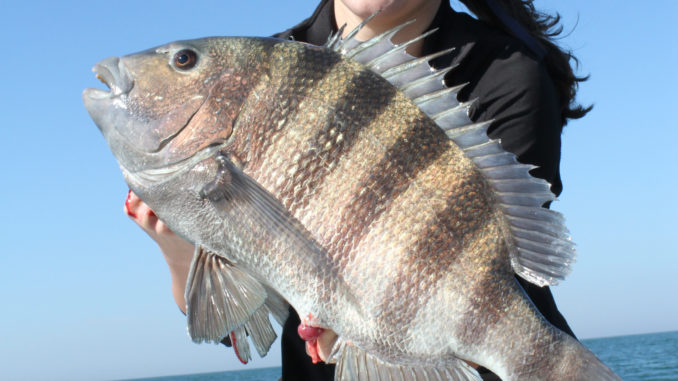
Sheepshead “smorgasbord” producing nice fish regularly
Capers Reef off the coast of Charleston is the place to be this month for sheepshead fishing. Capt. Jim Dodge of Charleston Fishing Guide said for numbers and size, Capers Reef is tough to beat. Dodge and his clients have been boating sheepshead that approach double-digits in weight, and he said they are biting throughout the tide cycles, with a slight lull at ebb tide.
Dodge (843-906-1622) said anglers don’t need to worry about going too stout on their tackle; he uses spinning tackle with reels in the 2500 to 3500 class. He said the most-important aspect of fishing this reef is to take your time anchoring over it. It’s tempting for anglers to just drop anchor as soon as they spot the reef on their depth finder, but Dodge said they need to look at other factors, such as wind direction and how the current will push the boat once it is anchored. Sometimes it takes pulling the anchor and repositioning more than once to make sure the boat is sitting over the reef. The extra time and work involved is well worth the effort and may mean the difference between getting skunked and putting fish in the boat.
Dodge said it is important for anglers to keep a watch on the boat position using a compass.
“If my compass shows I’m lying at 180 (degrees) and I’m catching fish, I want to stay at 180 until the bite stops, but any change in wind or current can push you off that mark,” he said. Sometimes that doesn’t hurt, as long as any movement keeps you above the reef, the fishing should remain strong. But if the bite dies off, adjust your position, either by letting out some anchor line, or pulling anchor and finding the reef again.
“The black sea bass are a bit of a nuisance out here, so you will catch your share of them,” said Dodge, “but some of them are keeper size, and they make good eating, too.”
But the real target is big sheepshead, and Dodge has been catching them with a “sheepshead smorgasbord” made up of one or two fiddler crabs and the meat from an oyster. He uses a Carolina rig with 1-ounce weights and threads the bait onto hooks in the 2/0 to 3/0 sizes with 20-pound line and 12- to 18-inch leaders.
Anglers should drop their bait straight down, then, once they feel it hit the reef, engage the reel and crank a few turns. This keeps the bait in the strike zone but off the reef where it can easily tangle. Dodge said when anglers get a bite, then feel like they are stuck on the reef, they shouldn’t feel discouraged. This often means a fish has taken the bait, then gone into a hole in the reef. Giving the fish some slack will often lead to the fish swimming out of the hole, then anglers need to reel the fish away from the structure.





Be the first to comment